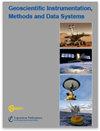The Soil heat flow sensor functioning checks, imbalances’ origins and forgotten energies
IF 2.3
4区 地球科学
Q3 GEOSCIENCES, MULTIDISCIPLINARY
引用次数: 2
Abstract
Abstract. Soil heat flux is an important component of the Surface Energy Balance (SEB) equation. Measuring it require an indirect measurement. Every used technique may present some possible errors tied with each specific technique, soil inhomogeneities or physicals phenomenon such as latent heat conversion beneath the plates especially in a desiccation cracking soil or vertisol. The installation place may also induce imbalances. Finally, some errors resulting from the physical sensor presence, vegetation presence or soil inhomogeneities may occur and are not avoidable. For all these reasons it is important to check the validity of the measurements. One quick and easy way is to integrate results during one year. The corresponding integration should be close to zero after a necessary geothermal heat efflux subtraction which should be included into the SEB equation for long term integrations. However, below plate evaporation and vegetation absorbed water or rainfall water the infiltration may also contribute to the observed short scale or/and long scale imbalance. Another energy source is usually not included in the SEB equation: the rainfall or irrigation. Yet its importance for a short- and long-term integration is notable. As an example, the most used sensors: Soil Heat Flux Plates (SHFP), is given.土壤热流传感器功能检查,不平衡的起源和被遗忘的能量
摘要土壤热通量是地表能量平衡方程的重要组成部分。测量它需要间接测量。每种使用的技术都可能存在一些可能的错误,这些错误与每种特定技术、土壤不均匀性或物理现象有关,如板下的潜热转换,尤其是在干燥开裂的土壤或垂直土壤中。安装位置也可能导致失衡。最后,由于物理传感器的存在、植被的存在或土壤的不均匀性,可能会出现一些无法避免的错误。出于所有这些原因,检查测量的有效性是很重要的。一个简单快捷的方法是在一年内整合结果。在必要的地热流出减法后,相应的积分应接近于零,该减法应包含在SEB方程中以进行长期积分。然而,板下蒸发和植被吸收的水或雨水渗透也可能导致观察到的短期或/和长期不平衡。SEB方程中通常不包括另一种能源:降雨或灌溉。然而,它对短期和长期一体化的重要性是显著的。作为一个例子,给出了最常用的传感器:土壤热通量板(SHFP)。
本文章由计算机程序翻译,如有差异,请以英文原文为准。
求助全文
约1分钟内获得全文
求助全文
来源期刊

Geoscientific Instrumentation Methods and Data Systems
GEOSCIENCES, MULTIDISCIPLINARYMETEOROLOGY-METEOROLOGY & ATMOSPHERIC SCIENCES
CiteScore
3.70
自引率
0.00%
发文量
23
审稿时长
37 weeks
期刊介绍:
Geoscientific Instrumentation, Methods and Data Systems (GI) is an open-access interdisciplinary electronic journal for swift publication of original articles and short communications in the area of geoscientific instruments. It covers three main areas: (i) atmospheric and geospace sciences, (ii) earth science, and (iii) ocean science. A unique feature of the journal is the emphasis on synergy between science and technology that facilitates advances in GI. These advances include but are not limited to the following:
concepts, design, and description of instrumentation and data systems;
retrieval techniques of scientific products from measurements;
calibration and data quality assessment;
uncertainty in measurements;
newly developed and planned research platforms and community instrumentation capabilities;
major national and international field campaigns and observational research programs;
new observational strategies to address societal needs in areas such as monitoring climate change and preventing natural disasters;
networking of instruments for enhancing high temporal and spatial resolution of observations.
GI has an innovative two-stage publication process involving the scientific discussion forum Geoscientific Instrumentation, Methods and Data Systems Discussions (GID), which has been designed to do the following:
foster scientific discussion;
maximize the effectiveness and transparency of scientific quality assurance;
enable rapid publication;
make scientific publications freely accessible.
 求助内容:
求助内容: 应助结果提醒方式:
应助结果提醒方式:


